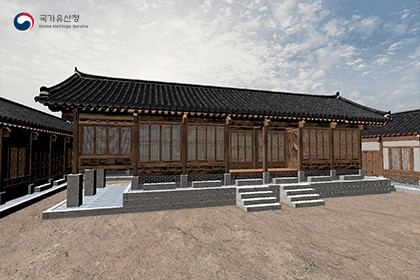
KOREA HERITAGE SERVICE [KHS]This is components of Korean Gyeongbokgung Palace; the complex of Jesuhab.Gyeongbokgung Palace 경복궁Gyeongbokgung Palace, the main palace in the Joseon Dynasty, was built after King Taejo, founder of the Joseon Dynasty. He had the capital moved to Hanyang during the fourth year of his reign (1395). Its name, literally meaning “great fortune,” originated with a phrase of Sigyeong (Book of Songs), quoted by Jeong Do-jeon, an eminent scholar in the Joseon Dynasty: "I've already drunk and have been full with virtue, so I will help you get great fortune in my late year as a man of virtue.”Jesuhab, Gyeongbokgung Palace 제수합A pavilion located northeast of Jagyeongjeon in Gyeongbokgung Palace. It is a pavilion located northeast of Jagyeongjeon in Gyeongbokgung Palace and is located within the National Folk Museum. It was built during the reconstruction of Gyeongbokgung Palace in 1865 (the 2nd year of King Gojong's reign), and there are no records of the purpose of Jesuhap, so it is unknown who used this building and how. It is a wooden building with 7 rooms on the front and 2 rooms on the side, and the 3-bead base was made by stacking pole stones. The roof is a gable roof, the eaves are single, and it was built in the Mindori style without any gaps. The interior of Jesuhap consists of a total of 7 rooms in the order of 1 numaru, 2 ondol rooms, 2 daecheong rooms, and 2 ondol rooms. [Naver Knowledge Encyclopedia] Gyeongbokgung JaesuhapFeatures:Complex of JesuhabNumber of Unique Meshes: 166Collision: YesVertex Count: 5 - 198,656LODs: NONumber of Material Instances: 20Number of Textures: 58Texture Resolutions: (1024*1024, 2048*2048, 4096*4096)Supported Development Platforms:Windows: (Yes)Mac: (No)







